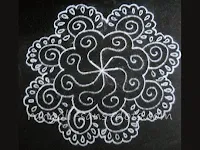If you have come here in search of rangoli designs without chukki , I can assure that you have come to the right website (place) because
the name is Rangoli sans dots which literally means rangoli without dots.
Of course there are many rangoli designs with dots too. There may be hundreds of both types. Take your pick :)
Again, just like lines, spirals when drawn at a single stretch make the rangoli design beautiful.
These tips are from the answers to the many questions on Facebook and YouTube viewers ask after watching my videos.
Though I upload videos on social media, I have to do justice to this website that has given me millions of views
so I regularly update this rangoli blog too.
1) The half circle rangoli design through images
2) Free hand semi-circle rangoli being drawn
The rangoli above with an intermediate step demonstrates a semi-circular kolam that you can try for your daily rangolis or with colours for festivals like Varamahalakshmi Habba.
2) In the pic a without dots kolam
The next rangoli above is the white companion of a colourful design shared elsewhere on this website. Use the search feature available on desktop version of the website to search for different types
3) In the photo a without dots rangoli on cement floor
Drawing thin long lines without a break and hence without a joint comes with practice as shown in the picture above. The secret is to use minimum quantity of white rangoli powder
4) Next image a without dots simple rangoli
5) In the picture - a bird kolam easy and sans dots
Two more white rangoli designs have been added. The design above demonstrates how to draw a without chukki birds rangoli. One of the most beautiful methods of representing birds through simple patterns is possible in rangoli.
6) Here is the free hand rangoli without colour
This rangoli sans chukki (!) in the image above is with simple patterns. White rangoli can be decorated with only kaavi for festivals like Sankranthi or Navarathri.
If I remember right all the patterns above were drawn by me on the kitchen counter. I practised while doing work in the kitchen.
Of course, there was a lot of space on the kitchen platform and hence there was no worry of anything spilling on the kolam or the kola powder getting sprinkled on the dishes.
I also added colours for all the rangolis. Fortunately, I took photographs of both the white and colourful designs. I have shared the ones with colours elsewhere on this kolam blog devoted to this art except for a few on festivals and festival related recipes.
The advantage of white kolam, according to me is that all the intricacies in the pattern are clearly visible, when we add colours, (I think) may be the small patterns get obfuscated.







Comments